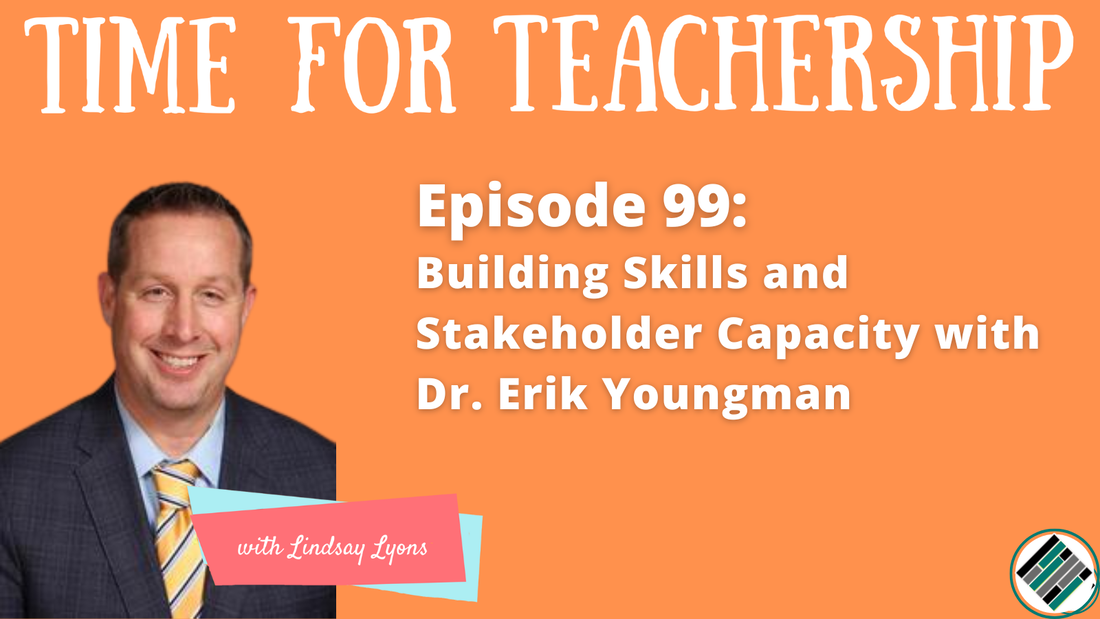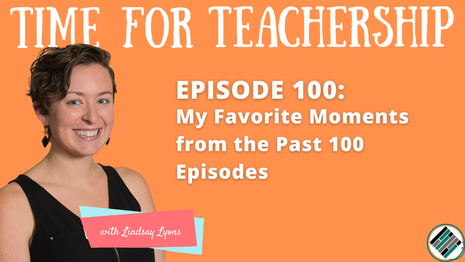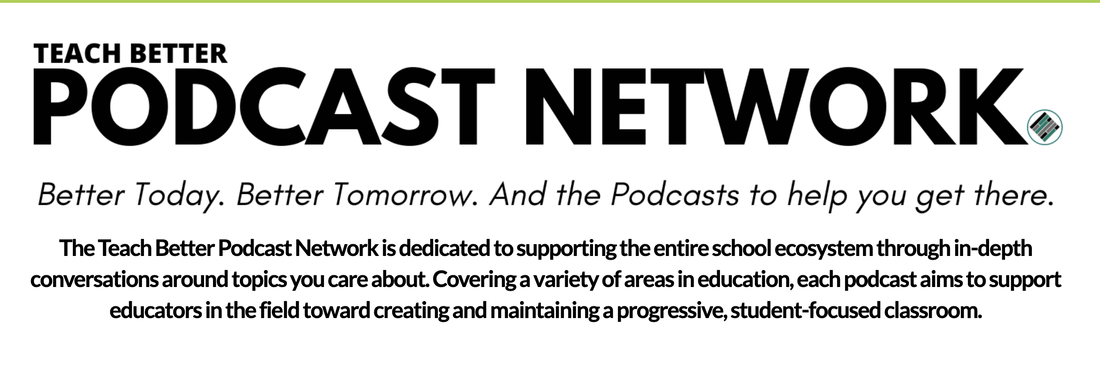|
Listen to the episode by clicking the link to your preferred podcast platform below:
We did it! 100 episodes later, the Time for Teachership Podcast is still here and stronger than ever. Thank you to all my listeners, all who are new to this community and all who have been here since day one. In this blog post, I will be sharing all the links that connect to the references I made in episode 100. Enjoy! Here are my top episode recommendations by category! Episodes on a Culture of Coaching Ep 1: Creating a Culture of Coaching with Romain Bertrand Related Mindsets... "How To" episodes on this...
Episodes on Mindset Shifts around Historically Marginalized Students
Episodes on Discourse
Episodes on Shared Leadership in Action
Episodes on Curriculum and Lesson Planning
Episodes on Curriculum in Action
Episodes That Will Make You Feel All the Feels
Episodes from the Students
Episodes Featuring Bold Visions
"How They Did It" Episodes On Leading District-Wide Curriculum Change
Did you know I have a YouTube Channel? Dive deeper with teacher PD by watching this video below:
0 Comments

Listen to the episode by clicking the link to your preferred podcast platform below:
How are we effectively educating students through a lens of equity and inclusion? And how are we preparing students for a future filled with unpredictability? These are two of the questions that framed our recent conversation with Dr. Erik Youngman on episode 99 of The Time for Teachership podcast. As an educator, a father, and an author, Dr. Youngman draws from years of diverse experience to pinpoint some of the important goals and directions for educators today. We covered a lot in this interview, so make sure you have a listen. Here are some of Dr. Youngman’s key insights that educators should take note of. Preparing Students for an Unknown Future Dr. Youngman’s big dream for education is to see all students develop important life skills. He names a few of them: kindness, curiosity, collaboration, creativity, critical thinking, and continuous learning. Why these skills? Two reasons:
By focusing on skill development like critical thinking and problem-solving—through disciplines of social studies, math, science, and everything in between—students are better equipped for their futures. Bringing Equity to the Classroom There are two equity lenses that are important in the classroom. Dr. Youngman discussed equity of learning opportunity and justice and equity-focused curriculum. The first, equity of learning opportunities, is related to strategic decision-making, grading practices, and curriculum delivery. The key question here is: Are all students equally able to learn, contribute, and have a voice? Consider the difference between a talkative student who always speaks up in front of class and one who doesn’t—do they both have equal voice? Centering student voice is essential to effective education, so think through how you are providing equal opportunities for all. The second discussion on equity relates to championing justice and equity in the classroom. Dr. Youngman emphasized the importance of defining and using terms correctly and not simply throwing “equity” around as a buzzword. Instead, it revolves around the concept of empathetic understanding to create belonging. It’s about ensuring all voices are heard. And it’s about asking the question: who’s story is being told through the content that’s being taught. Effective Planning and Grading To grade or not to grade—the much-debated question in any educator’s circle. Grading, in Dr. Youngman’s perspective, is essential to track progress and provide objective standards. But grading is not about the grades. It’s about the learning. So, how do you set up your grading system, rubric, or method that promotes learning, encourages, growth through “failure,” and doesn’t penalize students as they grow. One example Dr. Youngman provided was giving students “zero” on an assignment—what’s the purpose? It skews their grade so dramatically and effectively penalizes them in the trial and learning phase. Instead, think of ways you can give students another chance to promote their learning and engagement with the material, rather than demoralizing them and halting progress. --- As you can see, we covered a lot on the podcast with Dr. Youngman! Make sure you listen to his full interview to capture all the nuggets of wisdom he provided. You can also follow him on Twitter at @Erik_Youngman, where he’s very active, or check out his website. Quotes:
If you enjoyed this episode, I'd highly recommend you take a look at this video on getting teacher buy-in.
1/16/2023 PRACTICE: An Assessment Tool to Measure Curriculum Implementation Success via Student VoiceRead Now
Listen to the episode by clicking the link to your preferred podcast platform below:
Have you ever wondered whether your new unit or curriculum was successful? Or, more basic--how can you even measure success? Educators often design and implement new units without a clear idea on how they’ll measure its success. But without knowing that, there’s no room to improve. And there’s no affirmation that it’s met the learning goals you want to meet. That’s why I’ve developed an assessment tool that measures curriculum implementation success. It’s framed by listening to student voices and soliciting feedback from your class about the unit. Why Student Voice Matters for Assessment Some units will “land” with students and others won’t. Or, within the same unit, you might have some who loved it and others who couldn’t keep up. But how will you know this information? You’ve got to ask. It’s simple: asking students for feedback on a unit will give teachers insight and understanding into the success of that unit. Teachers can then take their feedback and incorporate it into the next time they teach the unit or their next unit plan. Student voice is the essential piece to this. So often we ignore student voice or don’t consider it important for the assessment of teachers. But their opinions and feedback on the units are some of the most important data points we can ever collect about how we’re doing. Assessment Tool to Measure Curriculum Implementation Success To effectively assess curriculum implementation success, you need to first facilitate a youth-adult partnership mentality among staff. I love how Michael Fielding calls it “radical collegiality,” or the idea that students and staff are partners in learning. Once that is established, you can move on to implementing this tool with your staff: 1. Coach teachers to create their next unit plan Start by coaching your teachers to develop their next unit plan. If you don’t personally coach them, provide support by way of mentorship or a course. This unit should meet three criteria:
2. Create a feedback culture After implementing the unit, teachers should invite students to reflect and provide feedback on the unit. This should be more than a one-time thing but become a culture of reflection that always happens on the last day of the unit. This is where my assessment tool comes in. It’s a simple questionnaire that can be tweaked or adjusted to what you need and is designed to elicit honest, open, and useful feedback from students. The questionnaire is designed to reflect on pre- and post-unit feelings or outcomes. It’s helpful to know how students felt about their learning before this unit and how they feel after it. Here are some of the questions:
3. Synthesize and share class themes After collecting feedback, you want to synthesize the class themes and share it back with students. Get curious about what they’re saying by seeking clarification on certain points. Then, assign yourself (and teachers) homework by taking up the action points the students provided. If you can’t act on a suggestion, be transparent about why that is. This process is integral to showing your students that their voice matters and will impact how teachers move forward teaching them. --- This entire process has to do with curiosity. Curiosity about how unit implementation is going and how students are receiving it. With this feedback, teachers can move forward with confidence knowing what works and doesn’t work and how to adjust things for the future. To access this assessment tool, simply click here. You can download the tool and adjust it based on your context. And, if you’re looking for more information and some examples on how to use it, listen to episode 98 of the Time for Teachership podcast, where I cover it in-depth. Quotes:
Want to continue learning more about curriculum development and implementation? Watch this video on how to develop district curriculum that challenges, affirms, and inspires:
1/9/2023 Developing a Short List of High-Yield Instructional Strategies with Dr. Edward SmallRead Now
Listen to the episode by clicking the link to your preferred podcast platform below:
In this episode, we get to learn from Dr. Ed Small who has held multiple teaching and leadership positions and has been recognized for his work at the national level. He’s now an Assistant Superintendent in Delaware, and I love how he says that being a husband and father drives his work with schools and students!
The Big Dream Schools should be about helping kids get what they want. Educational landscape, the community, and family/home are 3 points of a triangle. We want students to yearn for school and their relationships with teachers. We want kids to think about school like Six Flags! Alignment to the 4 Stages: Mindset, Pedagogy, Assessment, and Content The school systems and instructional framework should stay the same in all classes so students don't need to learn to code switch. For example, the warm up in one class is called a warm up in every class. Students should only need to be grappling with the content, not the culture or expectations. Currently, the district has 16 common instructional strategies as a district, and they’re working on getting down to 8 or 9 so everyone knows what they are. Doing less is doing more! Some of our current instructional strategies include: clear learning intentions and success criteria, collaborative structure (e.g., Socratic Seminar), and chunking. Dr. Small recommends schools or districts have 4 collaborative structures everyone uses, and then once those are really going well, adding a few more. Action Steps He cites advice he received: “When you go into a classroom, you should be looking to paint on a canvas, but you need a canvas to paint on before you can start painting.” The canvas includes the high-yield instructional strategies. An instructional leader can identify where a protocol can leverage the energy present in a class. Behavior is communication. A coach can suggest a movement-based activity to focus a high-energy class. We use praise statements and growth action statements to frame coaching conversations. Praise might be: “I noticed you did X well because it’s good for Y. Keep doing this!” Growth action statements might look like: “I noticed you were doing Z. Maybe try ___ instead. I look forward to coming back in a month to see how it’s going. Let’s talk about it to make sure kids are benefitting from this idea.” Challenges? Nobody likes to be critiqued. It requires trust, relationship-building, and the chance to talk about it. Teachers need to know that leaders and coaches want them to win. When teachers win, we all win. The cost of leadership is time. Leaders have to invest time in conversations with teachers to gain that level of trust. One Step to Get Started Leaders, take an inventory of your relationship with your teachers. (Teachers, you can take inventory of your relationship with your leader.) Have there been opportunities for you to grow together? And if the relationships need to be improved, spend time building relationships. Stay Connected You can find this week’s guest on Twitter @DoctorEsmall or via email at [email protected]. To help you start building your list of common instructional strategies, I’m sharing a recording of my Circle protocol workshop with you for free. (This is my favorite protocol of all time.) And, if you’re looking for more details on the ideas in this blog post, listen to episode 97 of the Time for Teachership podcast. If you’re unable to listen or you prefer to read the full episode, you can find the transcript here. Quotes:
If this episode grabbed your interest, take a look at this video below where I share a strategy for reducing cognitive load and teacher planning time:
Listen to the episode by clicking the link to your preferred podcast platform below: We know how important personalized learning is for students, and many of us are working to implement it in the classroom. But it’s important for educators, too. Each educator is a unique individual with a different learning style. If we want to see educators step up into their best, most engaged and effective self in the classroom, personalized learning plans are a must. On episode 96 of the Time for Teachership podcast, I dove into how you can start personalized learning plans with your staff. Check out the full episode or read on here for the key takeaways. Why is Personalized Learning for Staff Important? I always want to start with the “why.” Why is personalized learning for staff so important? There are a few key reasons:
How to Create Personalized Learning Plans for Educators As a pre-cursor to creating personalized learning plans for educators, your school or district needs to identify 1-2 focus areas for the year and be clear on them. When your team is familiar with those big 1-2 focus areas, you can start creating personalized learning plans. Here are 6 steps to follow:
Listen to episode 96 of the Time for Teachership podcast to hear more about this topic. And, make sure you check out Dallas ISD’s Coaching and Development Rubric. It’s an awesome resource to help you on this personalized learning journey! Quotes:
If you enjoyed this episode, take a look at this related content on rubric design for assessments:
|
Details
For transcripts of episodes (and the option to search for terms in transcripts), click here!
Time for Teachership is now a proud member of the...AuthorLindsay Lyons (she/her) is an educational justice coach who works with teachers and school leaders to inspire educational innovation for racial and gender justice, design curricula grounded in student voice, and build capacity for shared leadership. Lindsay taught in NYC public schools, holds a PhD in Leadership and Change, and is the founder of the educational blog and podcast, Time for Teachership. Archives
May 2024
Categories |


 RSS Feed
RSS Feed